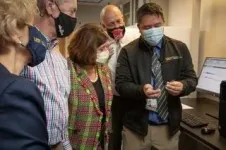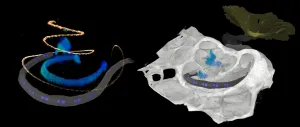INFORMATION:
Additional authors on the study include Taylor Howard, Julia Loegering, Brett Phinney, and Michelle Salemi, University of California, Davis; Ryan Walsh, Shimadzu Scientific Instruments; and John Pepper, Allegiant Travel Company.
Link to video: https://youtu.be/Sy2tGAVL2uU
Multimedia file: https://ucdavis.app.box.com/s/5k9hfmefx6xwkzx8iwi8lxt716thhdia
New rapid COVID-19 test the result of university-industry partnership
Innovative platform pairs mass spectrometry with machine learning
2021-04-26
(Press-News.org) A partnership between UC Davis and Maurice J. Gallagher, Jr., chairman and CEO of Allegiant Travel Company, has led to a new rapid COVID-19 test.
A recent study published Nature Scientific Reports shows the novel method to be 98.3% accurate for positive COVID-19 tests and 96% for negative tests.
"This test was made from the ground up," said Nam Tran, lead author for the study and a professor of pathology in the UC Davis School of Medicine. "Nothing like this test ever existed. We were starting with a clean slate."
The novel COVID-19 test uses an analytical instrument known as a mass spectrometer, which is paired with a powerful machine-learning platform to detect SARS-CoV-2 in nasal swabs. The mass spectrometer can analyze samples in minutes, with the entire process taking a total of about 20 minutes.
The accuracy matches or outperforms many of the current COVID-19 screening tests. The new testing method may allow for the rapid screening of large numbers of individuals for businesses, schools, venues and other large facilities. The project originated with Gallagher, a UC Davis alumnus and a longtime supporter of innovation and entrepreneurship at UC Davis.
Last year, when the pandemic brought the airline and hospitality industries almost to a standstill, he began conceptualizing approaches that would allow people to gather again safely.
Gallagher approached H. Rao Unnava, professor and dean of the UC Davis Graduate School of Management, who connected him with Tran at the School of Medicine.
Gallagher and UC Davis entered into a Sponsored Research Agreement, with support from Shimadzu Scientific Instruments, to develop an automated COVID-19 test on a mass spectrometer.
Mass spectrometers are essential analytic tools used by a wide variety of industries for research and testing.
This is the first test for COVID-19 that pairs mass spectrometry with robotics and a robust automated machine learning platform to rapidly deliver test results. The coupling of these unique elements not only allows testing for COVID-19 but may be able to quickly adapt to detect other diseases and perhaps future pandemic organisms.
"Mr. Gallagher, through his generosity as an alum, has shown how business and universities can work together in solving problems of critical importance to the world," said Unnava. "I am glad that this groundbreaking work will continue to build on the reputation of UC Davis as a place where you always 'Expect Greater.'"
Project builds on the prior success of MILO platform
The collaboration is part of a new center in the School of Medicine, the UC Davis Center for Diagnostic Innovation.
"This game-changing, rapid new COVID-19 test speaks to the deep expertise of our faculty and scientists to find novel solutions to pressing global health challenges," said Allison Brashear, dean of the UC Davis School of Medicine. "It's this kind of innovation and collaboration that has been the hallmark of our response to the pandemic."
To ensure support for the study's analytic portion, Tran enlisted Hooman Rashidi, a longtime collaborator and a professor in the Department of Pathology and Laboratory Medicine.
The machine, a mass spectrometer MALDI-TOF, or matrix-assisted laser desorption/ionization time-of-flight, uses a laser to create small particles -- ions -- from large molecules in the testing sample. These ionized particles create signals that can be used to identify many compounds, including those associated with microorganisms and pathogens.
For the study, 226 nasal swabs from UC Davis' biorepository of COVID-19 tests were ionized in the Shimadzu 8020. The swabs were from leftover samples and volunteers who consented to the study. Some of the participants had COVID-19 symptoms, and some were asymptomatic.
The hundreds of peaks and signals produced by the ionized test swabs were analyzed by the automated machine learning platform MILO (Machine Intelligence Learning Optimizer). Machine learning is a subset of artificial intelligence, or AI. Tran, Rashidi and Samer Albahra are the co-developers of MILO. The platform has previously been used to predict severe infections and acute kidney disease.
For the COVID-19 test, MILO finds distinguishing patterns among the many mass spectrometry peaks and signals and deciphers which patterns correspond to the presence or absence of the SARS-CoV-2 virus in the samples.
MILO accomplished the analysis in a fraction of the time that a non-automated machine-learning approach would have taken. "This meant drastically expediting the study without compromising any performance measures," said Rashidi.
Gallagher has launched a new startup, SpectraPass, to develop the rapid, automated system into a means to facilitate opening businesses and the economy.
Experts at UC Davis Health are helping guide the SpectraPass team through the scientific, machine learning and clinical steps needed to move the COVID-19 testing technology closer to emergency use authorization by the Food and Drug Administration (FDA).
"The COVID-19 pandemic not only brought the world's commerce and travel to a halt - it also took away our fundamental human interaction, our freedom to be together," said Gallagher. "This project has resulted in a real breakthrough that can not only provide instant, accurate information about COVID infection, but can be an important part of addressing other viruses and even developing therapies. The excitement of working with the team at UC Davis is in knowing we are helping make sure our children and grandchildren are better equipped to deal with potential pandemics in the future."
The partnership exemplifies the goals of Aggie Square, which brings together the university, community and industry to connect and collaborate.
"As a top-tier research university known for its excellence and disciplinary breadth, UC Davis is exceptionally well-positioned to work with our industry partners on groundbreaking innovations that benefit society," said Mary Croughan, provost and executive vice chancellor.
ELSE PRESS RELEASES FROM THIS DATE:
Social tensions preceded disruptions in ancient Pueblo societies
2021-04-26
PULLMAN, Wash. - Climate problems alone were not enough to end periods of ancient Pueblo development in the southwestern United States.
Drought is often blamed for the periodic disruptions of these Pueblo societies, but in a study with potential implications for the modern world, archaeologists have found evidence that slowly accumulating social tension likely played a substantial role in three dramatic upheavals in Pueblo development.
The findings, detailed in an article in the Proceedings of the National Academy of Sciences, showed that Pueblo farmers often persevered through droughts, but when social tensions were increasing, even modest droughts could spell the end of an era of ...
First village-level mapping of childhood undernutrition in India reveals local disparities
2021-04-26
The risk of childhood undernutrition varies widely among villages in India, according to new research led by Harvard T.H. Chan School of Public Health in collaboration with researchers at Harvard's Center for Geographic Analysis, Harvard's Center for Population and Development Studies, Korea University, Microsoft, and the Government of India.
The study is the first to predict and map the burden of childhood undernutrition across all of the nearly 600,000 villages in rural India, and the methods developed to do so could be applied to other health indicators and help advance the field of "precision public health," in which interventions and policies are tailored to smaller populations that are disproportionally ...
Icy clouds could have kept early Mars warm enough for rivers and lakes, study finds
2021-04-26
One of the great mysteries of modern space science is neatly summed up by the view from NASA's Perseverance, which just landed on Mars: Today it's a desert planet, and yet the rover is sitting right next to an ancient river delta.
The apparent contradiction has puzzled scientists for decades, especially because at the same time that Mars had flowing rivers, it was getting less than a third as much sunshine as we enjoy today on Earth.
But a new study led by University of Chicago planetary scientist Edwin Kite, an assistant professor of geophysical sciences and an expert on climates of other worlds, uses a computer model to put forth a promising explanation: Mars ...
Better hearing with optical cochlear implants
2021-04-26
Understanding spoken words, developing normal speech - cochlear implants enable people with profound hearing impairment to gain a great deal in terms of quality of life. However, background noises are problematic, they significantly compromise the comprehension of speech of people with cochlear implants. The team led by Tobias Moser from the Institute for Auditory Neuroscience and InnerEarLab at the University Medical Center Göttingen and from the Auditory Neuroscience and Optogenetics Laboratory at the German Primate Center - Leibniz Institute for Primate Research (DPZ) is therefore working to improve cochlear implants. The scientists want to use genetic engineering methods to make the nerve cells in the ear ...
Human genome editing requires difficult conversations between science and society
2021-04-26
MADISON, Wis. -- In October of 2020, Jennifer Doudna and Emmanuelle Charpentier were awarded the Nobel Prize in chemistry for their discovery of an adaptable, easy way to edit genomes, known as CRISPR, which has transformed the world of genetic engineering.
CRISPR has been used to fight lung cancer and correct the mutation responsible for sickle cell anemia in stem cells. But the technology was also used by a Chinese scientist to secretly and illegally edit the genomes of twin girls -- the first-ever heritable mutation of the human germline made with genetic engineering.
"We've moved away from an era of science where we understood the risks that came with new technology and where decision stakes were ...
UBCO researcher re-evaluates estimate of the world's high-altitude population
2021-04-26
New findings detailing the world's first-of-its-kind estimate of how many people live in high-altitude regions, will provide insight into future research of human physiology.
Dr. Joshua Tremblay, a postdoctoral fellow in UBC Okanagan's School of Health and Exercise Sciences, has released updated population estimates of how many people in the world live at a high altitude.
Historically the estimated number of people living at these elevations has varied widely. That's partially, he explains, because the definition of "high altitude" does not have a fixed cut-off.
Using novel techniques, Dr. Tremblay's publication in the Proceedings of the National ...
Genetic discovery in songbird provides new insights
2021-04-26
New research reveals a genetic quirk in a small species of songbird in addition to its ability to carry a tune. It turns out the zebra finch is a surprisingly healthy bird.
A study published today in the journal Proceedings of the National Academy of Sciences reveals that zebra finches and other songbirds have a low-density lipoprotein receptor (LDLR) gene surprisingly different than other vertebrates.
The function of LDLR, which is responsible for cellular uptake of LDL-bound cholesterol, or "bad cholesterol," has been thought to be conserved across vertebrates. OHSU scientists found that in the case ...
Structure gives insight into how plants keep their "mouths" shut
2021-04-26
Stomata, formed by a pair of kidney-shaped guard cells, are tiny pores in leaves. They act like mouths that plants use to "eat" and "breathe." When they open, carbon dioxide (CO2) enters the plant for photosynthesis and oxygen (O2) is released into the atmosphere. At the same time as gases pass in and out, a great deal of water also evaporates through the same pores by way of transpiration.
These "mouths" close in response to environmental stimuli such as high CO2 levels, ozone, drought and microbe invasion. The protein responsible for closing these "mouths" is an anion channel, called SLAC1, which moves negatively charged ions across the guard cell membrane to reduce turgor pressure. Low pressure causes the guard cells to collapse and subsequently the stomatal pore to ...
New study provides insight in identifying, treating lung cancer at early stages
2021-04-26
(Boston)--Lung carcinomas are the leading cause of cancer-related deaths in the United States and worldwide. Lung squamous cell carcinomas (non-small cell lung cancers that arise in the bronchi of the lungs and make up approximately 30 percent of all lung cancers) are poorly understood, particularly with respect to the cell type and signals that contribute to disease onset.
According to the researchers, treatments for lung squamous cell carcinomas are limited and research into the etiology of the disease is required to create new ways to treat it.
"Our study offers insight into how damage ...
Genetic changes in head and neck cancer, immunotherapy resistance identified
2021-04-26
A multi-institutional team of researchers has identified both the genetic abnormalities that drive pre-cancer cells into becoming an invasive type of head and neck cancer and patients who are least likely to respond to immunotherapy.
"Through a series of surprises, we followed clues that focused more and more tightly on specific genetic imbalances and their role in the effects of specific immune components in tumor development," said co-principal investigator Webster Cavenee, PhD, Distinguished Professor Emeritus at University of California San Diego School of Medicine.
"The genetic ...
LAST 30 PRESS RELEASES:
NTP-enhanced lattice oxygen activation in Ce-Co catalysts for low-temperature soot combustion
Synergistic interface engineering in Cu-Zn-Ce catalysts for efficient CO2 hydrogenation to methanol
COVID-19 leaves a lasting mark on the human brain
Scientists use ultrasound to soften and treat cancer tumors without damaging healthy tissue
Community swimming program for Black youth boosts skills, sense of belonging, study finds
Specific depressive symptoms in midlife linked to increased dementia risk
An ‘illuminating’ design sheds light on cholesterol
Who is more likely to get long COVID?
Study showcases resilience and rapid growth of “living rocks”
Naval Research Lab diver earns Office of Naval Research 2025 Sailor of the Year
New Mayo-led study establishes practical definition for rapidly progressive dementia
Fossil fuel industry’s “climate false solutions” reinforce its power and aggravate environmental injustice
Researchers reveal bias in a widely used measure of algorithm performance
Alcohol causes cancer. A study from IOCB Prague confirms damage to DNA and shows how cells defend against it
Hidden viruses in wastewater treatment may shape public health risks, study finds
Unlock the power of nature: how biomass can transform climate mitigation
Biochar reshapes hidden soil microbes that capture carbon dioxide in farmland
Reducing saturated fat intake shows mortality benefit, but only in high-risk individuals
Manta rays create mobile ecosystems, study finds
Study: Mixed results in using lipoic acid to treat progressive multiple sclerosis
Norbert Holtkamp appointed director of Fermi National Accelerator Laboratory
New agentic AI platform accelerates advanced optics design
Biologists discover neurons use physical signals — not electricity — to stabilize communication
Researchers discover that a hormone can access the brain by hitchhiking
University of Oklahoma researcher awarded funding to pursue AI-powered material design
Exploring how the visual system recovers following injury
Support for parents with infants at pediatric check-ups leads to better reading and math skills in elementary school
Kids’ behavioral health is a growing share of family health costs
Day & night: Cancer disrupts the brain’s natural rhythm
COVID-19 vaccination significantly reduces risk to pregnant women and baby
[Press-News.org] New rapid COVID-19 test the result of university-industry partnershipInnovative platform pairs mass spectrometry with machine learning





